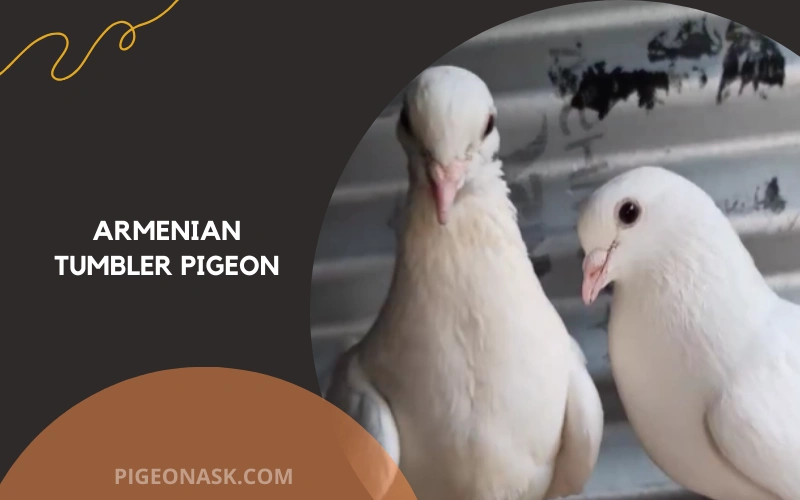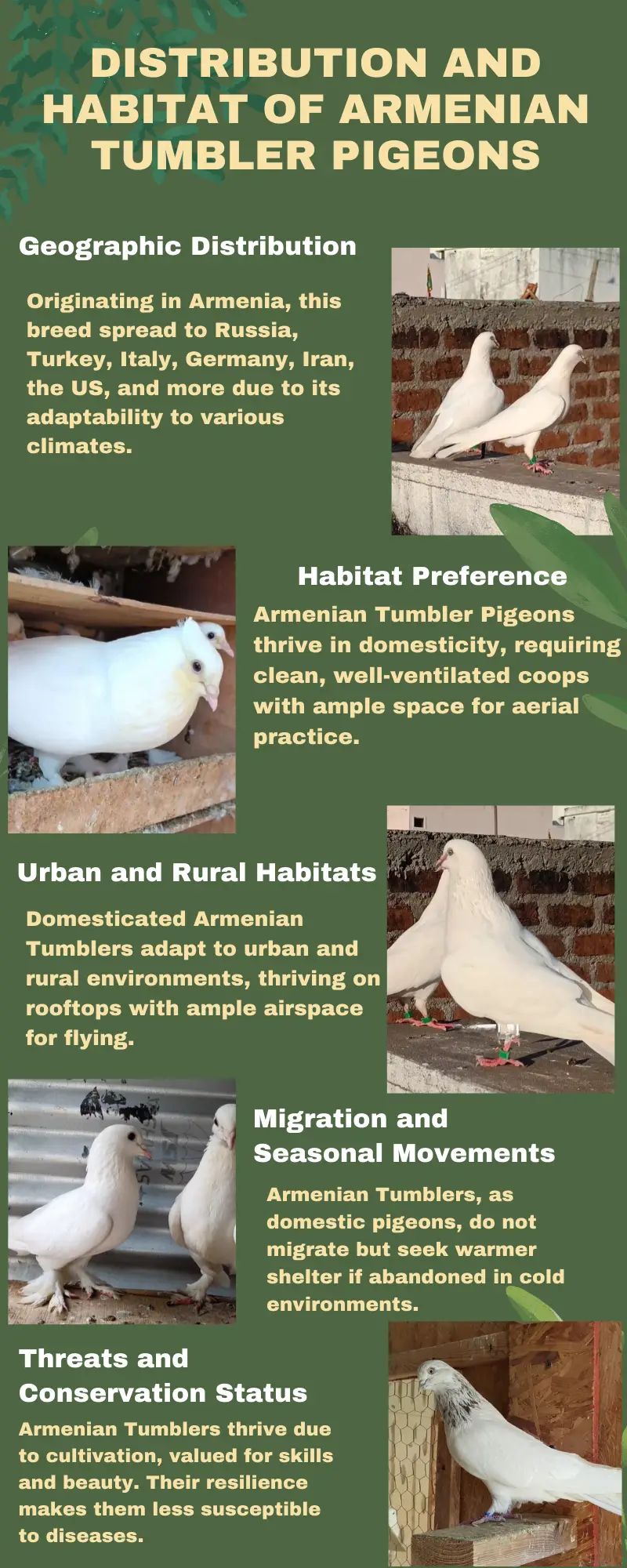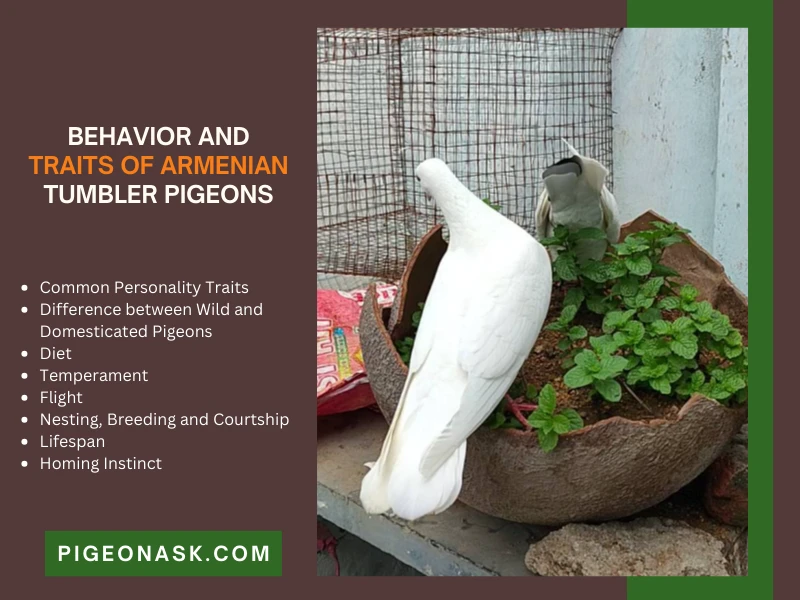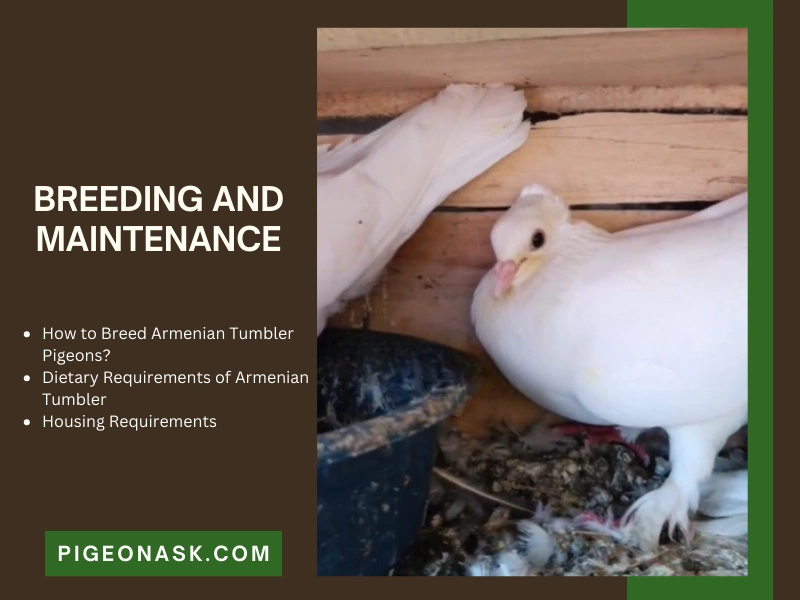Armenian Tumbler Pigeon: Breed Guide
Whether or not you are a pigeon fancier, the tumblers shall never fail to amaze you.
Their acrobatic skills are one of the major attractions at pigeon shows. Among the various breeds of aerial acrobats, the Armenian Tumbler Pigeon is a truly remarkable one.
Originating in Armenia, the Armenian Tumbler has now gained worldwide popularity. They have a distinct pattern of color and markings known as Bellneck.
Another desirable trait of these pigeons is their ability to spin or somersault in mid-flight. These pigeons make loyal, docile and beautiful pets.

Well-trained Armenian Tumblers are in high demand among pigeon enthusiasts. Healthy adult birds can sell for hundreds of dollars. And the good thing is they are low-maintenance birds. Find out more about this pigeon and how to breed them.
Armenian Tumbler Pigeon Profile
| Name | Features |
|---|---|
| Scientific Name | Columba livia |
| Common Names | 01. Culbutant d’Armenia 02. Armenischen 03. Purzeltaube 04. Capitombolanto in Armenia 05. Aрмянский голубь |
| Origin | Armenia |
| Size | Medium size |
| Weight | 200-250g |
| Lifespan | 5-10 years ( can be more if taken proper care) |
| Physical Features | 01. Crested/non-crested round head 02. Neck color contrasts with the rest of the body, which is considered a beauty factor of this breed. 03. Muffed feet (another desirable trait) |
| Temperament | Non-aggressive and friendly |
| Behavior | Socialable and trainable |
| Special Features | ● Bellneck ● Feathered Feet ● Can perform aerial acrobatics |
| Breeding and Maintenance | ● Breeds four times a year with two eggs per clutch ● Low-maintenance birds since they are remarkably sturdy. |
| Common or Popular Varieties (According to colors and markings) | ● Crested Armenian Tumblers ● Non-crested Armenian Tumblers ● Blacktail and Black neck ● Yellow-tail and Yellow-neck ● Solid color variants ● Magpie Markings |
Interested in similar topics on pigeon breed:
Overview
As is evident from their name, the Armenian Tumbler pigeon is from Armenia. Like other tumbler pigeons, they can perform spins, rolls, somersaults and similar aerial acrobatics.
The breed also has French (Culbutant d’Armenia). German (Armenischen Purzeltaube), Italian (Capitombolanto in Armenia), and Russian names (армянский голубь).
The literal translations of these names are more or less the same as the Armenian Tumbler or Armenian Pigeon. Plus, the many names are an indication of the worldwide fame and demand of this breed.
Unlike most fancy breeds, Armenian Tumblers are hardy birds. They don’t easily get sick and can find their way back home. This means cultivators don’t have to worry too much about maintenance.
Usually, the adult birds sell for about $100-$150. However, a well-trained tumbler can sell for more than that.
History And Origins of Armenian Tumbler Pigeons
It was probably during the 1800s when the breed first appeared in Armenia. From then on, pigeon fanciers have cultivated them for their magnificent color and amazing flight qualities.

They probably came to America along with the Armenian immigrants. The Armenian Tumbler Pigeon is the result of years of careful selective breeding.
Therefore, it’s exclusively domestic and not wild birds.
However, that doesn’t make them any less soft. Since they originate in the harsh climates of Armenia, the birds can withstand more stress than other fancy breeds.
Also, the Pigeon breeders chose strong parents with exceptional tumbling abilities to create them. Some close relatives of the Armenian Tumbler include the Kazan Tumbler and the West of England Tumbler.
Physical Characteristics And Features
Pigeon lovers adore the Armenian Tumbler Pigeon for its beautiful physical features.
The colors and markings on their body are extraordinary. They have bellnecks, muffed feet, crested heads and sometimes different-colored eyes.

1. Appearance
The Armenian Tumbler doesn’t appear any larger than the average pigeon. However, they have better aesthetics. Their heads are comparatively rounder and sometimes have a tuft of feather (crest).
They also have yellow or orange eyes. The beak is usually medium-sized and light pink or black.
2. Size and Body Structure
These pigeons have a well-proportionate body suited for an acrobat. They are broad-chested with a wide back. The slightly curved neck is adequately thick.
The tail is short compared to the strong, long wings. Overall, it has a stout and compact body structure.
3. Weight
The Armenian Tumbler Pigeone weighs similar to the ordinary pigeon. So, most of them are in the 200-250g category.
However, flight training, diet and genetics can sometimes make them even lighter. Age, sex, season and molting also affect the weight of the pigeons.
4. Unique Features
The bellneck and muffed feet are two of this pigeon’s most unique visual features. Bellneck means their neck and tail feathers are different colors than the rest of the body.
They also have boots or muffed feet. In other words, the feather covering the birds’ toes reaches up to their ankles.
5. Colors and Marking Variations
Armenian pigeons can have black, brown or yellow neck and tail feathers. In contrast, the rest of the body is usually light-colour or white.
The pigeons can also be of a single color. Some Armenian Pigeons have magpie-like markings on their tails and wings.
Distribution And Habitat
The Armenian Tumbler isn’t limited to their original country. Pigeon fanciers all over the world have bred them for their exceptional capabilities.

1. Geographic Distribution
The breed has its origin in Armenia. It later spread to Russia, Turkey, Italy, Germany, Iran, the United States, and many others. Since these pigeons can adjust to different climates, their geographical distribution is widespread.
Habitat Preference
The Armenian Tumbler Pigeon is an exclusively domesticated bird. They won’t live in the wilderness and prefer coops or lofts, which are clean, well-ventilated and have adequate food and water supply.
Their habitat should be spacious enough for the birds to practice their aerial skills.
Urban and Rural Habitats
As long as they are domesticated, the Armenian Tumbler can survive in both urban and rural settings. Rooftops are one of the best sites to set up their lofts since it would provide them with enough Skyview and airspace.
Migration and Seasonal Movements
Being a domestic pigeon, the Armenian Tumbler doesn’t migrate. Abandoned birds might move to a warmer and comfortable spot if the environment is too cold.
Threats and Conservation Status
These pigeons aren’t a threatened breed since people cultivate them for their skills and beauty. Moreover, these robust pigeons are less vulnerable to diseases than other fancy breeds.
However, they are not a wild species. So, the breed would perish if pigeon lovers stopped keeping them.
Behavior And Traits of Armenian Tumbler Pigeons
Like most domesticated pigeons, the Armenian Tumbler is a docile breed. They get along well with humans and other pigeons. You would find them to be loyal pets. But they do have the low-key unique traits that set them apart from other pigeons. Have a look –

Common Personality Traits
These pigeons are not aggressive, but they are still competitive when it comes to flying. You can easily train them to perform various acrobatics, which indicates their superior intelligence.
Difference between Wild and Domesticated Pigeons
Although strong and tough, the Armenian Pigeon doesn’t possess some of the traits of wild pigeons. For instance, they aren’t quick to react against predatory attacks. Also, they crave human bonds, which is unlike wild pigeons.
Diet
The Armenian Tumbler mostly prefers grains and seeds. These provide all the energy and nutrients for their development and flight performance.
They also eat worms (for protein), fruits and veggies. The pigeons will also require water and grit for proper digestion.
Temperament
These are gentle pigeons who have long been bred for companionship. Therefore, you will find them most friendly and interactive. Plus, they don’t make a lot of noise or create commotion.
Flight
The Armenian Tumblers are well-known for their exceptional flying skills. They can fly continuously for about 2-3 hours. Tumbling or rolling in mid-air is their trademark move and a spectacular sight for the audience.
However, they don’t possess the extreme flight stamina of racing pigeons.
Nesting, Breeding and Courtship
The Armenian Tumbler mates for life. Both parents will participate in incubating the eggs and raising the hatchlings. They usually breed two times a year. Although, favorable conditions can encourage a few more broods.
They usually make a nest out of feathers, twigs or sticks in their loft.
Lifespan
You can expect an Armenian Tumbler to live up to 10 years. However, with good genetics and excellent maintenance, they can live as long as 15 years in captivity.
Homing Instinct
The Armenian Pigeon has a moderate homing instinct. They can fly a few hundred miles away from home and return. However, their homing instincts aren’t as strong as a messenger or racing pigeons.
Breeding And Maintenance
You don’t have to invest too much time and effort in maintaining Armenian Tumblers. However, if you want the birds to have excellent aerial skills, beautiful plumage and a long life, then proper care is necessary.

How to Breed Armenian Tumbler Pigeons?
Start with a healthy pair of pigeons for better offspring in the future. An ideal pair should be compatible, have a strong, stocky build and be free of parasites. You should also choose a pair with the color patterns you desire for the future generation.
Don’t crossbreed Armenian Tumbler pigeons with non-tumbler pigeons. Avoid inbreeding and choose partners who possess the same traits.
The mating pair would need a spacious loft free from interference. A dark, cold, chaotic and dirty space would discourage the pigeons from breeding. They should also have access to fresh water and seeds.
In each brood, the female will lay two eggs. Both parents shall incubate the eggs for around three weeks. If you have multiple pigeons in your keep, then you can use identification rings on the hatchling’s feet to separate them from other pigeons.
You can start flight training in the fourth week and gradually increase the distance of flying.
Use a whistle to signal the birds to fly away or come back. The more you let them fly, the quicker and better they will develop their natural tumbling instincts.
Dietary Requirements of Armenian Tumbler
The Armenian Tumbler eats a standard pigeon diet. It mostly consists of grains and seeds. Wheat, millet, barley and sunflower seeds are at the top of the list.
For greens and fruits, you can give them lettuce, spinach, carrots and apples. These foods will provide the nutrients that contribute to the vibrancy of their feather color.
Adult birds usually eat 30-40 grams of food per day. Growing pigeons will require a bit more for their developing bodies.
Birds that regularly fly for hours and perform tumbling will need more protein, carbohydrates and fat for energy and muscle maintenance. However, too much food can make the birds obese and hinder their acrobatic skills.
You smash charcoal and oyster shells to prepare grit. Besides helping the pigeons with digestion, the crushed shells will also provide calcium for their bones.
Housing Requirements
The Armenian Pigeon prefers rooftop lofts. Each bird should get at least 8-10 cubic feet of air space to fly freely. You must ensure proper ventilation and plenty of sun. During the seasons, with shorter daytime, use a 100-watt bulb to light up the loft.
Ideally, the loft should’ve three partitions. One for the young birds in training, one for the breeding couple and another for the older pigeons. Provide enough feeders, waterers and nest boxes with respect to the number of birds.
Cover the floor with sawdust, sand or straw to absorb moisture and dropping. The ceiling should be high enough for the caretaker to stand upright.
You must secure the doors and windows from predators. For instance, put up wire meshes and alarms to discourage cats, raccoons and foxes.
Unlike other fancy pigeons, this breed doesn’t require a high degree of cleanliness. However, they are still vulnerable to parasites and diseases. So, ensure dryness of the loft. You can also sterilize the loft once a month with bleach water.
Final Words
The Armenian Tumbler Pigeon is a loveable and magnificent breed. Investing some time to care for the birds can be very rewarding. Of course, breeders who want to raise skilled flyers have to spend more time training the birds.
You must regularly take the birds away from home out into an open space, let them fly and gradually increase the distance each day. This would make their homing instincts stronger.
That’s all for this discussion. If you found it helpful, share the knowledge with other pigeon fanciers. Don’t forget to follow us on Facebook, X and Pinterest for more content like this.
